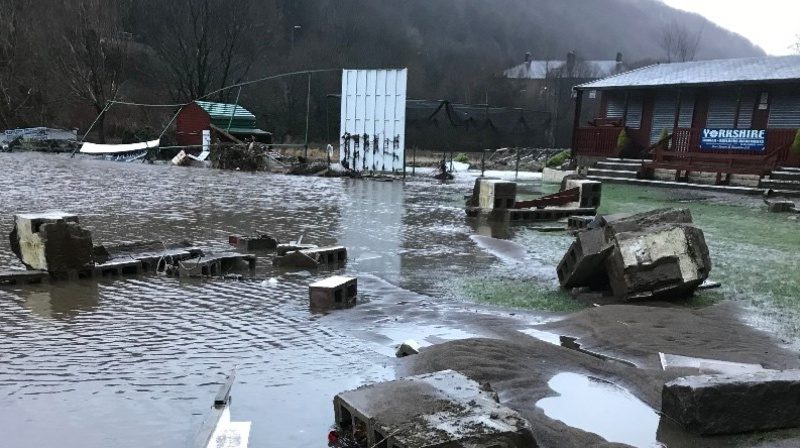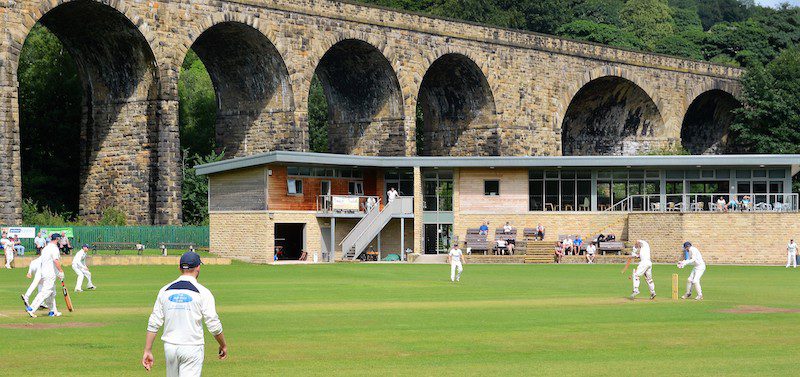In the last decade, cricket clubs in Yorkshire have been battered repeatedly by the wave of storms to hit the UK.
Dudley, Eunice and Franklin might sound friendly enough but the hat-trick of meteorological havoc that arrived on these shores in a single week in February 2022 was unprecedented.
Volunteers at cricket clubs find themselves in a cycle of floods and damage, insurance claims, exhausting repairs and waiting for the next one.
Are storms and floods getting worse? Meteorologists do love a record-breaking stat but those on the ground ripping up sodden carpets or building flood defences are almost numb to their frequency.
For this feature, I’ve talked to cricket clubs in West Yorkshire who know all too well about this ongoing challenge – but it could easily be Worcestershire or Wales.
The Yorkshire Cricket Board and England & Wales Cricket Board have both contributed data to add to the picture too.

Bridgeholme Cricket Club
Bridgeholme Cricket Club is such a success story despite everything that Mother Nature throws at it. Which is a hell of a lot.
The video footage above is from the Boxing Day floods of 2015 that devastated this attractive club, with views of Stoodley Pike, who play in the Halifax Cricket League.
Groundsman Keith Hudson has lived next to the ground since 1963 and he’s in no doubt that the impact of weather is increasing:
‘Over the last 10 years, the problems of flooding have worsened considerably. It is only the very worst floods that cause damage, this seems to be every 3 years or so. We are actually flooded at least 3 times a year!’
Keith admits it’s been incredibly frustrating and demoralising, during his service of 37 years and counting for Bridgeholme, to always rebuild and repair while trying to move the club forward.
To see what Keith has done at Bridgeholme is to understand someone who takes enormous pride in his work and retains a dogged determination that other clubs can doubtless relate to.
He reckons the cost over the last 10 years amounts to £75,000 but with financial support from the ECB and YCB, allied with countless hours from Keith and others, there’s an element of futureproofing.
‘I do worry for the future a little, if things get even worse then the safeguards we have in place now might not be enough. I’m also getting older and clear-ups on the scale of the last one are extremely hard work. Not sure I have another one in me, to be honest.’
The river wall has been rebuilt and should prevent river waters coming onto the field. Should being the operative word.
For Keith, who has made Bridgeholme his life’s work, there remains that nagging doubt:
If you Google Bridgeholme Cricket Club, my article comes up with pictures of their floral displays (grown from seed by Keith’s partner Sharon) and that’s how it should be remembered.
It’s immaculate during the summer with painted signs, hand-made bench seating and bags of character.
The one note of caution is who carries the torch for these cricket grounds that need such devotion in years to come?
Keith’s reply was telling: ‘That scares me more than flooding, John. I’ve tried several times to get the lads to come and learn the ropes but no takers so far.’
‘It’s a crap job at the end of the day and one I just fell into, to be honest. You start off just wanting to pull your own weight but pretty soon you’re tugging a busload!’
Ilkley Cricket Club
Floods at Ilkley Cricket Club are nothing new. Like Bridgeholme, proximity to a Yorkshire river means they bear the brunt.
Unfortunately, the flood defences were breached in February which is when it can get very expensive.
They’re now looking to raise £50,000 to pay for renovations to the bar, clubhouse and changing rooms. What struck me was the fact it’s been their fifth flood in four years.
What do you do if your cricket club is on a flood plain? I half-jokingly said to Ilkley CC that they should build on stilts – but that’s exactly what neighbours Olicanian are doing with an elevated design that’s coming along nicely.
In the case of Ilkley, President Richard Simpson was blunt in his assessment:
‘In many ways, it would have been better if we had lost the clubhouse to the flood, however, this is not the case, nor will it be. For this reason, we are metaphorically suffering the death of a thousand cuts and therefore something must be done. It is estimated that the new clubhouse will cost in the region of 400k.’
Ilkley’s Andy Wheeler got in touch via the Cricket Yorkshire Facebook page to share some thoughts on the latest setback.
‘One of our older members who has been a stalwart of the club for over 60 years told me that prior to 2005, the club had been flooded just once – but in the last 10 years we’ve been done 8 or 9 times.’
They must have broken a fair few mirrors in Ilkley as neighbours Olicanian Cricket Club had their wooden pavilion burnt to the ground and Ilkley had barely finished mopping up in February 2020 when they were flooded again in April.
Each club’s geography and geology will affect how they get hit, alongside what feels like the whim of increasingly spiteful weather patterns.
Global warming is unquestionably the headline here.
On the other side of the world, there’s the opposite problem to the one we’re having in Yorkshire. By 2040, the Australian Climate Council thinks heatwaves in Sydney and Melbourne could reach 50°C.
A renewable energy initiative caught my eye, backed by Australia’s Test captain Pat Cummins, called Cricket for Change that sees international cricketers help grade and local cricket clubs to install rooftop solar panels and inverters, at no cost to the clubs.
Meanwhile back in the UK, we’ll shortly look at what’s being done in Yorkshire, through the Yorkshire Cricket Board along with how the England & Wales Cricket Board (ECB) are involved.
But first, we ought to marvel – and grimace – at another cricket club, Copley, in the Halifax Cricket League.

Copley Cricket Club
If you’ve never been, you’re in for a treat. Its location is both a blessing and a curse. The rumble of trains over the viaduct behind the striking, modern clubhouse in this slab of Calderdale green is offset by the echo of LBW appeals.
Helen Hoyle is Co-Chair at Copley Cricket Club and gave me the background on a club I’ve visited a few times.
They have been flooded in June 2012, Boxing Day 2015, February 2020 and February 2022. The damage caused in the last decade amounted to over £350,000 to put right.
In the two major floods to hit Copley in recent times, the club has had to relay the whole outfield and square. It’s not so much volume of water on the ground that’s the problem but the silt and everything else that wrecks grass growth.
The cricket club does now have flood barriers that at least prevented last month’s stormwater from getting into the building.
As Helen pointed out, each clear-up takes hundreds of volunteer hours and fundraising is constantly around bouncing back from another flood.
Officially opened in September 2012, Copley’s new pavilion is visually impressive and inside, it’s a modern space, bathed in light with the option to sit outside and watch the cricket from the balcony.
The project cost £585,000 with substantial grants from ECB/Sports England, SITA Environmental Trust and others. The paint had barely dried when it was clobbered by the elements.
It is symptomatic of Copley’s struggles that the June 2012 flood meant they couldn’t play at home for months in a season that was meant to be a celebration.
Investment since has been in things like a flood-resilient lift and carpet, replacing wooden benches with recycled plastic alternatives and a flood plan to move everything upstairs or off-site at the end of each season.
They’ve even had to rebuild the front wall of the building which was pushed in by the force of the water in February 2020. For good measure, CCTV allows them to view the water levels remotely like a grim documentary unfolding before them.
Support (financial or expertise) has come from Yorkshire County Cricket Club, Yorkshire Cricket Board and ECB, along with Community Foundation for Calderdale and Calderdale Council.
Flood insurance is now seemingly impossible for Copley and they’ve never been able to secure insurance for the ground and nets; no doubt they raise a few red flags.
Colin Mico from Cricket Yorkshire’s insurance partner Aston Lark, pointed out that Met Office records show storms are no longer confined to October to March.
The storm seasons have also started earlier (in September) twice in the last four years, catching clubs before they have put their equipment away.
Cricket insurance considerations
He recommends: ‘If you do not have storm and weather cover for your equipment in the open, you will be facing damage to practice nets, sightscreens, and covers without recourse to insurance, and will have to pay for the repair or replacement out of your own funds.’
Colin offered: ‘If you do not know whether you have the cover, then read your insurance schedule and summary of cover. If it is still not clear, then please contact me and I will give you a definitive answer.’
I’m sure some cricket clubs feel trapped and helpless because of their location which makes them inevitable targets again and again.
As Helen put it: ‘We are constantly on alert when the weather forecast is for rain & storms. It is a continual worry – we have experienced four ‘once in a lifetime’ floods in 10 years.’
It takes 2 hours to put the flood barriers up, often in difficult circumstances as you can imagine, and an hour to get them down again (they can’t be left up as they prevent access for fundraisers and events). The flood barriers are about six years old and will need replacing soon. And so it goes on…
For Copley, the future is uncertain but Helen sees collaboration with partners as the key to a way forward:
‘We are currently working in partnership with the Environment Agency and others around additional drainage requirements and have secured a grant towards 2% of the total costs.’
She said: ‘We know we have to play our part to protect Copley Village as we are a designated flood plain, but we need to find new ways of allowing the water to drain away quickly to minimise the damage.’

ECB & YCB Support for Flooded Clubs
Steve Archer, the Yorkshire’s Cricket Board’s Head of Region for West Yorkshire explained the process of helping cricket clubs.
After consultation with affected clubs, the YCB offers a £500 Emergency Grant for any immediate/urgent work or to offset insurance excess claims.
There is ECB advice for those cricket clubs affected by flooding that includes reacting to a flooding event and planning/risk management. It points out that there might be a safety / environmental situation such as contaminated receding water for clubs to consider before launching into repairs.
After assessing what isn’t covered by insurance, the YCB has advised clubs to apply to Sport England for support (as of March 2022, there is emergency funding for flood-damaged facilities).
After any grant offer from Sport England, Steve says the YCB asked clubs to keep them posted on any additional costs not covered through Sport England to explore other avenues.
19 cricket clubs across Yorkshire have been affected by the February 2022 storms, with over £1m having been awarded via ECB Emergency Grants since 2012.
Dan Musson, Head of Facilities Planning at the ECB, told me:
‘In terms of clubs recently affected, we are supporting them directly through the ECB Facilities team and they can request help by emailing us at [email protected], which will see a case manager assigned to liaise with them.’
Sport England has an Emergency Fund open since those February storms that clubs are no doubt tapping into. An application isn’t a guarantee of success though, particularly given it covers multiple sports, so Dan said:
‘We will help clubs to understand their position, get advice and apply to Sport England’s fund. If clubs have additional costs beyond the scope of insurance and Sport England funding then we will help them with additional funding.’
It’s worth pointing out too that the ECB has its own funding around Tackling Climate Change for clubs.
In addition, according to Dan, ‘county cricket boards are being asked by the ECB to prioritise flood resilience in the short term and they are all in the process of developing a 10-year facilities strategy (due for 2023) which will see the issue of climate change much higher on cricket’s agenda.’
There’s no quick fix here and without seeking to strike a sombre tone, it’s only going to get worse in future, if the last decade is anything to go by.
How recreational cricket plans and funds its response to climate change will be so important if clubs are to become proactive rather than reactive and better equipped.
The sight of my local cricket club, Bradford & Bingley, with the flood waters heading towards its roof and a gigantic lake as far as the eye could see will stay with me.
What is unquestionably inspiring is the collective will of cricket club volunteers to clean up, get everything back to how it was and go again.
Want to comment or share this article?
Thanks to everyone who contributed to this article. It’s a small snapshot of the picture in Yorkshire but also good to get the perspective of clubs, YCB and ECB.
Do you know a cricket club that’s been affected? What more can be done in future? Have your say with a comment below and share the article using the Twitter/Facebook buttons below.
- 2026: Predictions and trends for grassroots cricket - December 19, 2025
- Cricket Gifts: The shortlist full of surprises[2026] - December 12, 2025
- 6 ways for cricket clubs to earn with easyfundraising - December 10, 2025
Sadly an all too familiar topic John and one that’s becoming an annual event these days, I fear with flash flooding these incidents will not just be confined to the winter months. I echo our friends comments from Bridgeholme and Copley CC, regarding the support from yourself, for highlighting the issues and from Dan Musson. the ECB, YCB, YCCC and the local leagues and clubs who have been absolutely phenomenal.
Financially these floods have a huge impact on any club big or small. And whilst many will see ‘funded support’ being the lifeline, each event takes everything you’ve got as a club in monetary, physical and emotional effort to keep going. It’s not easy waiting for the flood alerts to go off or see the ground slowly being swallowed up after only a couple of days of rain or watching and waiting for the river to burst its banks.
“Well you could move higher up the valley” I’ve heard commented. But these views are taken with a pinch of salt as they are not made by anyone who belongs to a club or who holds their own club as close to their heart as many of us do.
The support given shows you’re not alone and your efforts are worth investing in. I dread to think of the solitary hours Keith has spent working on the ground and the thoughts going through his head, but knowing he has the very highest level of our game wanting and willing him to succeed is of huge comfort.
All we can do is keep future proofing, in the defences, in the grounds and the facilities as it’s too good a game and community to just give up.
Thanks Steve, very well expressed. I remember our conversation after Sowerby Bridge CC was hit in the Boxing Day floods. You’ll know yourself the toll it takes more than most. Makes it worthwhile though when you can watch cricket at SBCC, a beautiful spot.
Thanks John, and that’s it, its the people that have gone before you and the ones still yet to enjoy it. We’ve been there nigh on 170 years so can’t let a bit of water break the spirit.
Our Cricket Club Bristol Dodos are building a hub for climate concerned cricketers. The Next Test. We are especially keen to hear the voices of the Clubs most at risk and the solutions that are in place to support them. please stay in touch to learn more.
https://twitter.com/TheNextTest